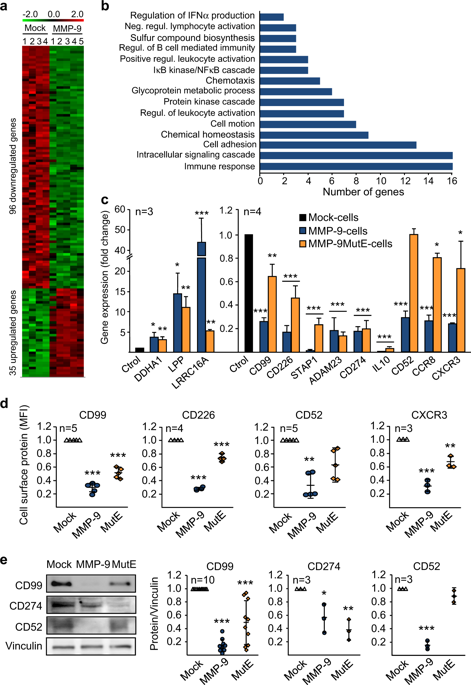Our official English website, www.x-mol.net, welcomes your feedback! (Note: you will need to create a separate account there.)
MMP-9 affects gene expression in chronic lymphocytic leukemia revealing CD99 as an MMP-9 target and a novel partner in malignant cell migration/arrest.
Oncogene ( IF 8 ) Pub Date : 2019-02-13 , DOI: 10.1038/s41388-019-0744-3 Noemí Aguilera-Montilla 1 , Elvira Bailón 1 , Rebeca Uceda-Castro 1 , Estefanía Ugarte-Berzal 2 , Andrea Santos 1 , Alejandra Gutiérrez-González 1 , Cristina Pérez-Sánchez 1 , Philippe E Van den Steen 2 , Ghislain Opdenakker 2 , José A García-Marco 3 , Angeles García-Pardo 1
Oncogene ( IF 8 ) Pub Date : 2019-02-13 , DOI: 10.1038/s41388-019-0744-3 Noemí Aguilera-Montilla 1 , Elvira Bailón 1 , Rebeca Uceda-Castro 1 , Estefanía Ugarte-Berzal 2 , Andrea Santos 1 , Alejandra Gutiérrez-González 1 , Cristina Pérez-Sánchez 1 , Philippe E Van den Steen 2 , Ghislain Opdenakker 2 , José A García-Marco 3 , Angeles García-Pardo 1
Affiliation

|
We previously showed that MMP-9 contributes to CLL pathology by regulating cell survival and migration and that, when present at high levels, MMP-9 induces cell arrest. To further explore the latter function, we studied whether MMP-9 influences the gene-expression profile in CLL. Microarray analyses rendered 131 differentially expressed genes in MEC-1 cells stably transfected with MMP-9 (MMP-9-cells) versus cells transfected with empty vector (Mock-cells). Ten out of twelve selected genes were also differentially expressed in MEC-1 cells expressing the catalytically inactive MMP-9MutE mutant (MMP-9MutE-cells). Incubation of primary CLL cells with MMP-9 or MMP-9MutE also regulated gene and protein expression, including CD99, CD226, CD52, and CD274. Because CD99 is involved in leukocyte transendothelial migration, we selected CD99 for functional and mechanistic studies. The link between MMP-9 and CD99 was reinforced with MMP-9 gene silencing studies, which resulted in CD99 upregulation. CD99 gene silencing significantly reduced CLL cell adhesion, chemotaxis and transendothelial migration, while CD99 overexpression increased cell migration. Mechanistic analyses indicated that MMP-9 downregulated CD99 via binding to α4β1 integrin and subsequent inactivation of the Sp1 transcription factor. This MMP-9-induced mechanism is active in CLL lymphoid tissues, since CD99 expression and Sp1 phosphorylation was lower in bone marrow-derived CLL cells than in their peripheral blood counterparts. Our study establishes a new gene regulatory function for MMP-9 in CLL. It also identifies CD99 as an MMP-9 target and a novel contributor to CLL cell adhesion, migration and arrest. CD99 thus constitutes a new therapeutic target in CLL, complementary to MMP-9.
中文翻译:

MMP-9影响慢性淋巴细胞白血病中的基因表达,揭示CD99作为MMP-9靶标,是恶性细胞迁移/逮捕的新型伴侣。
我们以前表明,MMP-9通过调节细胞存活和迁移而有助于CLL病理,并且当MMP-9高水平存在时,它会诱导细胞停滞。为了进一步探索后者的功能,我们研究了MMP-9是否影响CLL中的基因表达谱。与通过空载体转染的细胞(模拟细胞)相比,微阵列分析在稳定转染了MMP-9的MEC-1细胞(MMP-9-细胞)中提供了131个差异表达的基因。在表达催化失活的MMP-9MutE突变体的MEC-1细胞(MMP-9MutE-细胞)中,十二种选择的基因中的十种也差异表达。将原代CLL细胞与MMP-9或MMP-9MutE一起孵育还可以调节基因和蛋白质表达,包括CD99,CD226,CD52和CD274。由于CD99参与白细胞跨内皮迁移,我们选择CD99进行功能和机理研究。MMP-9基因沉默研究加强了MMP-9和CD99之间的联系,从而导致CD99上调。CD99基因沉默显着降低CLL细胞粘附,趋化性和跨内皮迁移,而CD99过表达则增加细胞迁移。机理分析表明,MMP-9通过与α4β1整合素结合并随后Sp1转录因子失活而下调CD99。这种MMP-9诱导的机制在CLL淋巴组织中很活跃,因为在骨髓源性CLL细胞中CD99表达和Sp1磷酸化程度低于外周血中的CD99表达和Sp1磷酸化。我们的研究建立了CLL中MMP-9的新基因调控功能。它还将CD99鉴定为MMP-9靶标,并且是CLL细胞黏附的新贡献者,移民和逮捕。因此,CD99构成了CLL中与MMP-9互补的新治疗靶标。
更新日期:2019-02-14
中文翻译:

MMP-9影响慢性淋巴细胞白血病中的基因表达,揭示CD99作为MMP-9靶标,是恶性细胞迁移/逮捕的新型伴侣。
我们以前表明,MMP-9通过调节细胞存活和迁移而有助于CLL病理,并且当MMP-9高水平存在时,它会诱导细胞停滞。为了进一步探索后者的功能,我们研究了MMP-9是否影响CLL中的基因表达谱。与通过空载体转染的细胞(模拟细胞)相比,微阵列分析在稳定转染了MMP-9的MEC-1细胞(MMP-9-细胞)中提供了131个差异表达的基因。在表达催化失活的MMP-9MutE突变体的MEC-1细胞(MMP-9MutE-细胞)中,十二种选择的基因中的十种也差异表达。将原代CLL细胞与MMP-9或MMP-9MutE一起孵育还可以调节基因和蛋白质表达,包括CD99,CD226,CD52和CD274。由于CD99参与白细胞跨内皮迁移,我们选择CD99进行功能和机理研究。MMP-9基因沉默研究加强了MMP-9和CD99之间的联系,从而导致CD99上调。CD99基因沉默显着降低CLL细胞粘附,趋化性和跨内皮迁移,而CD99过表达则增加细胞迁移。机理分析表明,MMP-9通过与α4β1整合素结合并随后Sp1转录因子失活而下调CD99。这种MMP-9诱导的机制在CLL淋巴组织中很活跃,因为在骨髓源性CLL细胞中CD99表达和Sp1磷酸化程度低于外周血中的CD99表达和Sp1磷酸化。我们的研究建立了CLL中MMP-9的新基因调控功能。它还将CD99鉴定为MMP-9靶标,并且是CLL细胞黏附的新贡献者,移民和逮捕。因此,CD99构成了CLL中与MMP-9互补的新治疗靶标。


























 京公网安备 11010802027423号
京公网安备 11010802027423号